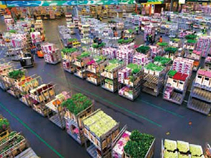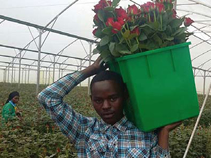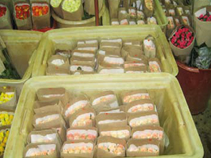 Consumer behaviour is always changing. Sometimes buyers want a good quality plant or bunch of flowers for a low price. At other times they want something very special and purchase price is not an issue. Millennials are driving further growth in online sales. Babyboomers are set to retire and are expected to increase their expenditure on flowers and plants. In the next decade, Rabobank is expecting a 2% growth per year in cut flower and potted plant expenditures in Europe and North America, with Asia growing 6-8% annually. Rabobank expects the growing demand in Asia to be mainly fulfilled by products grown in Asia.
Consumer behaviour is always changing. Sometimes buyers want a good quality plant or bunch of flowers for a low price. At other times they want something very special and purchase price is not an issue. Millennials are driving further growth in online sales. Babyboomers are set to retire and are expected to increase their expenditure on flowers and plants. In the next decade, Rabobank is expecting a 2% growth per year in cut flower and potted plant expenditures in Europe and North America, with Asia growing 6-8% annually. Rabobank expects the growing demand in Asia to be mainly fulfilled by products grown in Asia.
Hybrid consumer
Nowadays, the cut flowers and plants consumer is unpredictable. One moment they want a very luxurious bouquet or exclusive plant, the next moment they buy a low-priced bunch of flowers at a discounter or big box retailer. They want different products at different times. We call this the ‘hybrid consumer’. This requires industry players to adapt their products and services to several consumer purchasing moments.
Millennials on the market
A buyer’s age plays an important role in floriculture. Millennials are likely to buy more flowers and plants. They are familiar with buying online, using payment-apps and seem less loyal to specific retailers. Consumers in the UK bought 14% of their flowers on internet in 2015! Responding to the needs of this generation is an important opportunity, because millennials also have purchasing power. They want easy-to-use products (packaging, postharvest treatment), are sensitive to positive characteristics (air purification, workingclimate, decoration), want freedom of choice (seasonal flowers, composition of the bouquet), and are familiar with new technologies (ordering, payment, maintenance).
Online purchasing up
Rabobank expects online purchases to account for 30% of all flower and plant purchases in 2027. In 2015, the market share of online purchases in major European markets varied between 3% (in Germany) to 14% (in the UK).
 Today, women account for almost 80% of the purchases at supermarkets, florists, or garden centres. This is quite different online. GMI market research in Germany, for example showed that, in 2016, men accounted for 73% of online purchases of cut flowers and potted plants, women for 27%. Canadian market research showed that 31% of male millennials are buying at least a part of their flowers and plants on the internet.
Today, women account for almost 80% of the purchases at supermarkets, florists, or garden centres. This is quite different online. GMI market research in Germany, for example showed that, in 2016, men accounted for 73% of online purchases of cut flowers and potted plants, women for 27%. Canadian market research showed that 31% of male millennials are buying at least a part of their flowers and plants on the internet.
Babyboomers still in the market Millennials are the new buyers but it remains relevant to keep serving the needs of current buyers of flowers and plants. Babyboomers will retire soon and enter a new phase of their life. Their new lifestyle (more time at home, in the garden, or on the balcony) will bring new opportunities for floriculture. In the next ten years, the number of people above 60 in Germany, France, and the UK, will rise by 10 million. Market opportunities will increase by anticipating the baby boomers’ needs. There are plenty of opportunities for increasing expenditure from them because they will have more attention for their direct environment (living room, balcony, garden) and service provision will increase).
Urbanisation = greening
According to the UN, the global population will grow to 9.7 billion people in 2050. Most of these extra people will live in large metropolitan areas. Going green in these future metropolitan areas is not a luxury, but a necessity—think of healthcare and wellbeing for citizens, temperature regulation, sewage disposal, and biodiversity in cities. City planners, architects, and policy makers feel this urgency.
Plans are therefore being made for green walls, urban jungles, and new parks at large-scale urban renewal projects in Asia and the US. This is going to provide opportunities for a whole range of (new) products.
It seems Europe is lagging behind a little in this regard, maybe because the European standstill in population growth is leading to less urbanisation than elsewhere. Urbanisation is a major opportunity for floriculture. We are especially convinced of the good opportunities for perennials, garden plants, and green potted plants. The trend is also relevant for flowering potted plants; but less important for cut flowers.
Economic growth: Higher demand for flowers and plants
In the next decade, consumption value in Asia is due to grow by 80%, based on the assumption of continuing economic growth and a strong relation between purchasing power and floriculture expenditures. For Europe and North-America, we are expecting growth in consumption value of 20% in the same period. This means consumption values in 2027 for Asia and Europe will be equal (USD 37 billion).

Production does not always equal market demand. At times of market disturbance, and for some specific species, there are opportunities for the current leading flowerexporting countries (Colombia, Ecuador, Ethiopia, Kenya, the Netherlands).
Rabobank expects Asian demand to be mainly fulfilled by flowers and plants from Asia. International transport to end users is not a sustainable business model, because of growing concerns about the CO2 footprint. Therefore, we expect growing consumer expenditures on products from the own continent.
Follow-up for companies
Floriculture has to put a lot of effort into responding to the changing behaviours when it comes to purchasing flowers and plants. Entrepreneurs have to be aware of these changes. Companies should choose to focus on economies-of-scale, high efficiency, big volumes and small margins or a choose the niches, specialities, exclusivity, lower volumes, high perception value, service, variation, and higher margins. Which choice a company makes does not actually matter too much. But making no choice at all is the most risky.
Source: Rabobank (Lambert van Horen)
